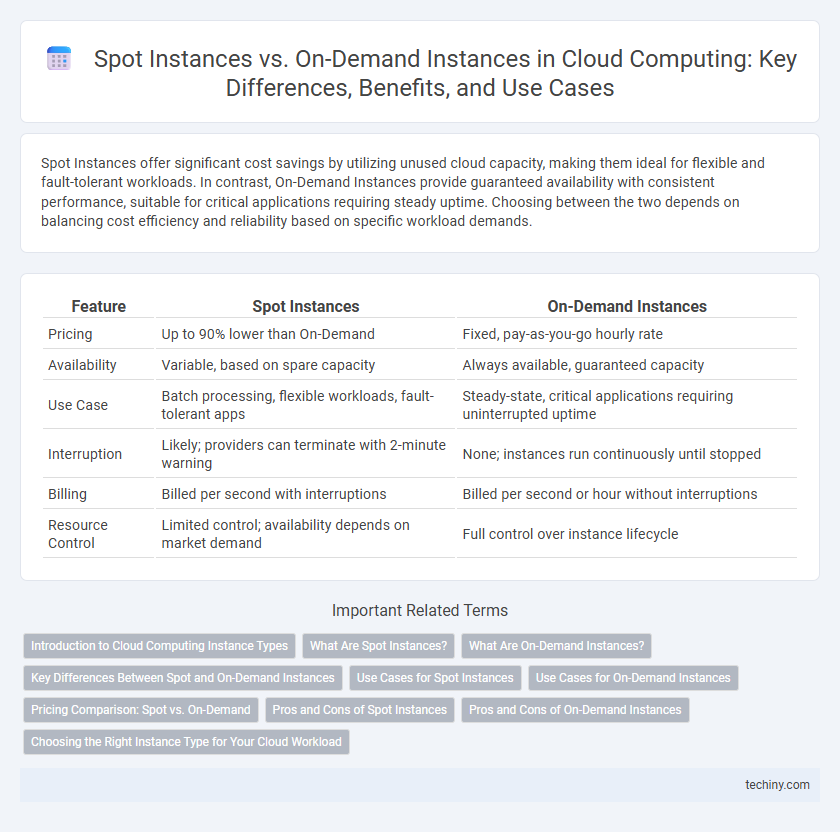Spot Instances offer significant cost savings by utilizing unused cloud capacity, making them ideal for flexible and fault-tolerant workloads. In contrast, On-Demand Instances provide guaranteed availability with consistent performance, suitable for critical applications requiring steady uptime. Choosing between the two depends on balancing cost efficiency and reliability based on specific workload demands.
Table of Comparison
| Feature | Spot Instances | On-Demand Instances |
|---|---|---|
| Pricing | Up to 90% lower than On-Demand | Fixed, pay-as-you-go hourly rate |
| Availability | Variable, based on spare capacity | Always available, guaranteed capacity |
| Use Case | Batch processing, flexible workloads, fault-tolerant apps | Steady-state, critical applications requiring uninterrupted uptime |
| Interruption | Likely; providers can terminate with 2-minute warning | None; instances run continuously until stopped |
| Billing | Billed per second with interruptions | Billed per second or hour without interruptions |
| Resource Control | Limited control; availability depends on market demand | Full control over instance lifecycle |
Introduction to Cloud Computing Instance Types
Spot Instances offer cost-effective, transient computing capacity by utilizing unused cloud resources at significantly lower prices, ideal for flexible and fault-tolerant applications. On-Demand Instances provide consistent, reliable performance with fixed hourly rates, enabling predictable workloads without long-term commitments. Selecting the appropriate instance type depends on workload characteristics, budget constraints, and the need for availability versus cost savings.
What Are Spot Instances?
Spot Instances are unused cloud computing capacity available at substantial discounts compared to On-Demand Instances, ideal for flexible workloads that can tolerate interruptions. These instances leverage surplus cloud resources and can be reclaimed by the provider with minimal notice, making them cost-effective for batch processing, data analysis, and development testing. Utilizing Spot Instances optimizes cloud spending by capitalizing on dynamic pricing models in major platforms like AWS, Azure, and Google Cloud.
What Are On-Demand Instances?
On-Demand Instances in cloud computing provide flexible, pay-as-you-go virtual servers without long-term commitments, allowing users to instantly launch and terminate instances based on workload demands. These instances offer consistent performance and reliable availability, making them ideal for unpredictable or short-term workloads. Pricing is calculated per second or hour, ensuring cost control without upfront investments.
Key Differences Between Spot and On-Demand Instances
Spot Instances offer significant cost savings by utilizing unused cloud capacity, but they can be interrupted with minimal notice, making them ideal for flexible, fault-tolerant workloads. On-Demand Instances provide stable, continuous availability with predictable pricing, suitable for steady-state or critical applications requiring guaranteed uptime. The key differences lie in pricing models, availability guarantees, and workload suitability, influencing decision-making for cost efficiency versus reliability in cloud resource management.
Use Cases for Spot Instances
Spot Instances provide cost-effective compute capacity, ideal for fault-tolerant workloads such as big data analysis, containerized applications, and batch processing jobs. They enable significant savings by utilizing unused cloud capacity, which is well-suited for flexible, non-critical operations that can handle interruptions. Use cases include machine learning model training, video rendering, and large-scale testing environments where workload interruptions are acceptable.
Use Cases for On-Demand Instances
On-Demand Instances provide scalable and flexible computing resources ideal for variable workloads without long-term commitments, making them perfect for development, testing, and unpredictable traffic spikes. They support critical applications requiring consistent availability and quick deployment, ensuring reliability when workload demands are uncertain. Companies leverage On-Demand Instances to avoid capacity planning and maximize agility in their cloud infrastructure.
Pricing Comparison: Spot vs. On-Demand
Spot Instances offer significantly lower pricing compared to On-Demand Instances by utilizing spare cloud capacity at discounts of up to 90%. On-Demand Instances provide fixed hourly rates without interruptions, ensuring steady availability but at a premium cost. Organizations optimize cloud budgets by balancing the cost-efficiency of Spot Instances with the reliability of On-Demand Instances based on workload tolerance.
Pros and Cons of Spot Instances
Spot Instances offer significantly lower costs compared to On-Demand Instances by leveraging unused cloud capacity, ideal for flexible, fault-tolerant workloads like batch processing and big data analysis. However, they come with the risk of sudden termination when demand spikes, leading to potential data loss or interrupted tasks if not properly managed. These instances require automated checkpointing and workload adaptability to mitigate the inherent volatility and ensure consistent performance.
Pros and Cons of On-Demand Instances
On-Demand Instances provide flexibility by allowing users to pay for compute capacity by the hour or second without long-term commitments, making them ideal for unpredictable workloads and development environments. They offer reliability and availability with no risk of instance termination due to pricing fluctuations, unlike Spot Instances. However, On-Demand pricing is significantly higher compared to Spot Instances, resulting in increased costs for steady-state or large-scale operations.
Choosing the Right Instance Type for Your Cloud Workload
Spot Instances offer significant cost savings by utilizing unused cloud capacity, making them ideal for flexible, fault-tolerant workloads such as batch processing and data analysis. On-Demand Instances provide reliable, consistent performance with fixed pricing, best suited for applications requiring steady availability and predictable scaling. Evaluating workload tolerance for interruptions and cost sensitivity is critical when selecting between Spot and On-Demand Instances for optimized cloud resource management.
Spot Instances vs On-Demand Instances Infographic

 techiny.com
techiny.com